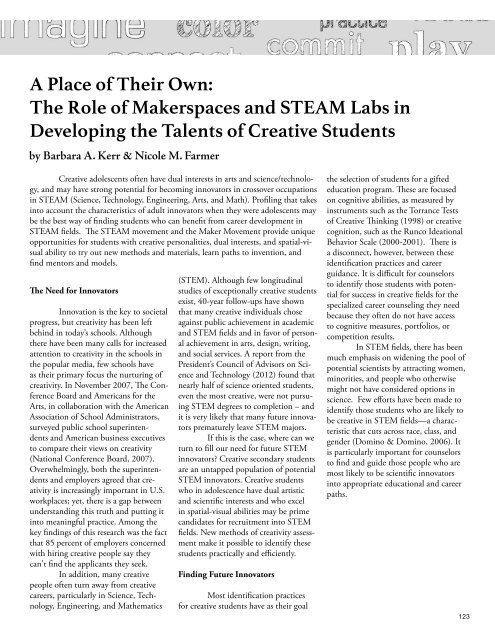Torrance Journal for Applied Creativity
TorranceJournal_V1
TorranceJournal_V1
You also want an ePaper? Increase the reach of your titles
YUMPU automatically turns print PDFs into web optimized ePapers that Google loves.
A Place of Their Own:<br />
The Role of Makerspaces and STEAM Labs in<br />
Developing the Talents of Creative Students<br />
by Barbara A. Kerr & Nicole M. Farmer<br />
Creative adolescents often have dual interests in arts and science/technology,<br />
and may have strong potential <strong>for</strong> becoming innovators in crossover occupations<br />
in STEAM (Science, Technology, Engineering, Arts, and Math). Profiling that takes<br />
into account the characteristics of adult innovators when they were adolescents may<br />
be the best way of finding students who can benefit from career development in<br />
STEAM fields. The STEAM movement and the Maker Movement provide unique<br />
opportunities <strong>for</strong> students with creative personalities, dual interests, and spatial-visual<br />
ability to try out new methods and materials, learn paths to invention, and<br />
find mentors and models.<br />
The Need <strong>for</strong> Innovators<br />
Innovation is the key to societal<br />
progress, but creativity has been left<br />
behind in today’s schools. Although<br />
there have been many calls <strong>for</strong> increased<br />
attention to creativity in the schools in<br />
the popular media, few schools have<br />
as their primary focus the nurturing of<br />
creativity. In November 2007, The Conference<br />
Board and Americans <strong>for</strong> the<br />
Arts, in collaboration with the American<br />
Association of School Administrators,<br />
surveyed public school superintendents<br />
and American business executives<br />
to compare their views on creativity<br />
(National Conference Board, 2007).<br />
Overwhelmingly, both the superintendents<br />
and employers agreed that creativity<br />
is increasingly important in U.S.<br />
workplaces; yet, there is a gap between<br />
understanding this truth and putting it<br />
into meaningful practice. Among the<br />
key findings of this research was the fact<br />
that 85 percent of employers concerned<br />
with hiring creative people say they<br />
can't find the applicants they seek.<br />
In addition, many creative<br />
people often turn away from creative<br />
careers, particularly in Science, Technology,<br />
Engineering, and Mathematics<br />
(STEM). Although few longitudinal<br />
studies of exceptionally creative students<br />
exist, 40-year follow-ups have shown<br />
that many creative individuals chose<br />
against public achievement in academic<br />
and STEM fields and in favor of personal<br />
achievement in arts, design, writing,<br />
and social services. A report from the<br />
President’s Council of Advisors on Science<br />
and Technology (2012) found that<br />
nearly half of science oriented students,<br />
even the most creative, were not pursuing<br />
STEM degrees to completion – and<br />
it is very likely that many future innovators<br />
prematurely leave STEM majors.<br />
If this is the case, where can we<br />
turn to fill our need <strong>for</strong> future STEM<br />
innovators? Creative secondary students<br />
are an untapped population of potential<br />
STEM innovators. Creative students<br />
who in adolescence have dual artistic<br />
and scientific interests and who excel<br />
in spatial-visual abilities may be prime<br />
candidates <strong>for</strong> recruitment into STEM<br />
fields. New methods of creativity assessment<br />
make it possible to identify these<br />
students practically and efficiently.<br />
Finding Future Innovators<br />
Most identification practices<br />
<strong>for</strong> creative students have as their goal<br />
the selection of students <strong>for</strong> a gifted<br />
education program. These are focused<br />
on cognitive abilities, as measured by<br />
instruments such as the <strong>Torrance</strong> Tests<br />
of Creative Thinking (1998) or creative<br />
cognition, such as the Runco Ideational<br />
Behavior Scale (2000-2001). There is<br />
a disconnect, however, between these<br />
identification practices and career<br />
guidance. It is difficult <strong>for</strong> counselors<br />
to identify those students with potential<br />
<strong>for</strong> success in creative fields <strong>for</strong> the<br />
specialized career counseling they need<br />
because they often do not have access<br />
to cognitive measures, portfolios, or<br />
competition results.<br />
In STEM fields, there has been<br />
much emphasis on widening the pool of<br />
potential scientists by attracting women,<br />
minorities, and people who otherwise<br />
might not have considered options in<br />
science. Few ef<strong>for</strong>ts have been made to<br />
identify those students who are likely to<br />
be creative in STEM fields—a characteristic<br />
that cuts across race, class, and<br />
gender (Domino & Domino, 2006). It<br />
is particularly important <strong>for</strong> counselors<br />
to find and guide those people who are<br />
most likely to be scientific innovators<br />
into appropriate educational and career<br />
paths.<br />
123


